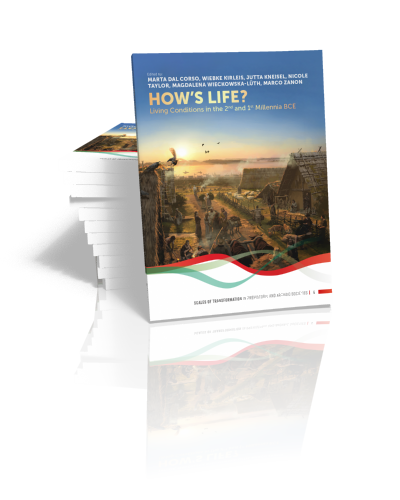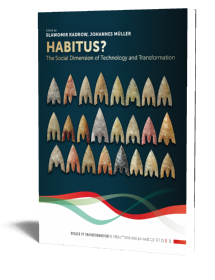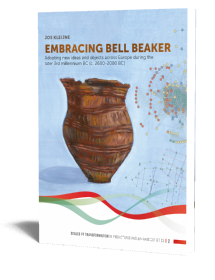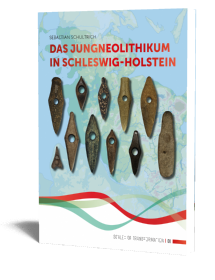Abstract:
The Bronze Age and Early Iron Age saw many developments in metalworking, social structure, food production, nutrition, and diet. At the same time, networks in Europe intensified and human impact on the environment changed in character. What influence did these transformations have on daily life? Which proxies can researchers use to study these topics?
This volume presents scientific contributions from different fields of expertise within modern archaeology in order to investigate past living conditions through aspects of the archaeological record related to production (e.g. of food and metal), well-being (e.g. diet, health), human relations (e.g. violence), and the local environment (e.g. pollution, waste disposal, and water management). It also critically addresses contemporary graphic representations of Bronze Age living conditions.
This volume compiles papers from a session with the same title organized for an international open workshop of the Graduate School ‘Human Development in Landscapes’, entitled ‘Socio-Environmental Dynamics over the Last 12,000 Years: The Development of Landscapes IV’, which took place in 2017, in Kiel, Germany. Publications detailing overarching core research on subsistence systems, societal transformations, and resilience versus rupture dynamics already exist. With this volume, we aim to provide a closer look at everyday life in past communities.
About the editors
The editors of this volume work at the Institute of Prehistoric and Protohistoric Archaeology of Kiel University in Germany, where four of them are currently active in different projects within the Collaborative Research Centre ‘Scales of Transformation – Human–Environmental Interaction in Prehistoric and Archaic Societies’ (CRC 1266, financed by the German Research Foundation/DFG). In addition, they are, or have been, involved in archaeological excavations and archaeobotanical/palaeoenvironmental projects at different Bronze Age sites across Germany, Poland, and Italy. Prominent examples include the excavations at Hünenburg, in collaboration with the University of Göttingen; at Bruszczewo, in collaboration with Poznań University; and at different southern alpine pile-dwellings (Castellaro Lagusello, in collaboration with CNR-IDPA in Milan, and Bande di Cavriana) and at the terramare settlement of Fondo Paviani, in collaboration with Padua University.
Contents
Introduction
Part 1. Life in Action: Metal Production, Health Conditions and Dietary choices
Copper Output, Demand for Wood and Energy Expenditure – Evaluating Economic Aspects of Bronze Age Metallurgy
Johanna Brinkmann
Warriors’ Lives. The Skeletal Sample from the Bronze Age Battlefield Site in the Tollense Valley, Northeastern Germany
Gundula Lidke, Ute Brinker, Annemarie Schramm, Detlef Jantzen, Thomas Terberger
Environmental Imposition or Ancient Farmers’ Choice? A Study of the Presence of “Inferior” Legumes in the Bronze Age Carpathian Basin (Hungary)
Sonja Filatova, Ferenc Gyulai, Wiebke Kirleis
Part 2. The Place of Living: Routine Activities, the Management of Waste and of Natural Resources
The Fossil Plant remains of the Early Bronze Age site Rothenkirchen on Rügen. Inside Distribution Patterns as a Mirror of Housekeeping
Almuth Alsleben
Waste Disposal In The Bronze Age: Plants In Pits At Wismar-Wendorf, Northern Germany
Dragana Filipović Frank Mewis, Lars Saalow, Jens-Peter Schmidt, Wiebke Kirleis
An Overview of Olive Trees in the Eastern Mediterranean during the Mid-Late Holocene: Selective Exploitation or Established Arboriculture?
Asli Oflaz, Walter Dörfler, Mara Weinelt
On-site Palaeoecological Investigations from the Hünenburg Hillfort–Settlement Complex, with Special Reference to Non-pollen Palynomorphs
Magdalena Wieckowska-Lüth, Immo Heske
Part 3. Living the Past: The (Graphic) Representation of Past Living Conditions
Creating an Understanding of Life in and around a Bronze Age House through Science-based Artist Impressions
Yvonne F. van Amerongen
Case Study “How Was Life in Early Bronze Age Bruszczewo” – Archaeology and the View of Prehistory in Reconstruction Images
Jutta Kneisel











